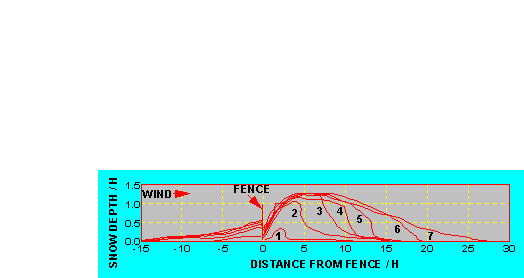Wind-blown Snow as a Water Resource
Basics of Blizzards and Snowdrift Control
How Snow Fence Drifts Grow
The way snowdrifts grow changes as blizzards fill the zone of reduced wind
speed around a porous snow fence (Tabler and Jairell 1993). Deposition begins
in the region of greatest wind speed reduction, extending to about 12H
downwind (H is fence height). As the snowdrift grows in height, a
recirculation zone and slip face form on the downwind edge. The plot of
drift growth shows this stage for profile measurements 1 through 3. Once the
drift attains its maximum height (1 to 1.2H), the recirculation zone begins to
fill (profiles 4 through 6). As the lee drift grows beyond 20H downwind from
the fence, less and less of each blizzard is trapped in the drift. With
enough blowing snow, the drift finally reaches a shape where it stops growing.
We call this the equilibrium drift, the most snow the fence will store. The
vertical scale is exaggerated in this plot to show the measurements more
clearly.

 To Basics of Snowdrift Control
To Basics of Snowdrift Control

 To Basics of Snowdrift Control
To Basics of Snowdrift Control